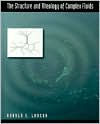The Structure and Rheology of Complex Fluids
Defying the classical definitions of solids and liquids, complex fluids include polymers, colloids, emulsions, foams, gels, liquid crystals, surfactants, and other materials that form flowable microstructures. They are vital to industries that produce polymers (e.g., plastic packaging), colloids (paint), foods (ketchup), and consumer products (toothpaste and shampoo), and are also used in countless other products manufactured by the petroleum, microelectronics, and pharmaceutical industries.
The first advanced textbook on this subject, The Structure and Rheology of Complex Fluids provides a multidisciplinary and comprehensive introduction to these fascinating and important substances. It offers an up-to-date synopsis of the relationship between the microstructure of complex fluids and their mechanical and flow properties, and also emphasizes the similarities and differences among the various types of complex fluids. Easy to read, it includes over 350 illustrations, extensive literature citations, and many interesting problems, worked examples, and practical applications. Featuring coverage of both foundational material and special topics, this text is highly adaptable for use in a one- or two-semester graduate-level course in chemical engineering, materials science, or physics. It also serves as a valuable monograph for academic and industrial researchers and as a reference book for researchers and educators.
1100484246
The first advanced textbook on this subject, The Structure and Rheology of Complex Fluids provides a multidisciplinary and comprehensive introduction to these fascinating and important substances. It offers an up-to-date synopsis of the relationship between the microstructure of complex fluids and their mechanical and flow properties, and also emphasizes the similarities and differences among the various types of complex fluids. Easy to read, it includes over 350 illustrations, extensive literature citations, and many interesting problems, worked examples, and practical applications. Featuring coverage of both foundational material and special topics, this text is highly adaptable for use in a one- or two-semester graduate-level course in chemical engineering, materials science, or physics. It also serves as a valuable monograph for academic and industrial researchers and as a reference book for researchers and educators.
The Structure and Rheology of Complex Fluids
Defying the classical definitions of solids and liquids, complex fluids include polymers, colloids, emulsions, foams, gels, liquid crystals, surfactants, and other materials that form flowable microstructures. They are vital to industries that produce polymers (e.g., plastic packaging), colloids (paint), foods (ketchup), and consumer products (toothpaste and shampoo), and are also used in countless other products manufactured by the petroleum, microelectronics, and pharmaceutical industries.
The first advanced textbook on this subject, The Structure and Rheology of Complex Fluids provides a multidisciplinary and comprehensive introduction to these fascinating and important substances. It offers an up-to-date synopsis of the relationship between the microstructure of complex fluids and their mechanical and flow properties, and also emphasizes the similarities and differences among the various types of complex fluids. Easy to read, it includes over 350 illustrations, extensive literature citations, and many interesting problems, worked examples, and practical applications. Featuring coverage of both foundational material and special topics, this text is highly adaptable for use in a one- or two-semester graduate-level course in chemical engineering, materials science, or physics. It also serves as a valuable monograph for academic and industrial researchers and as a reference book for researchers and educators.
The first advanced textbook on this subject, The Structure and Rheology of Complex Fluids provides a multidisciplinary and comprehensive introduction to these fascinating and important substances. It offers an up-to-date synopsis of the relationship between the microstructure of complex fluids and their mechanical and flow properties, and also emphasizes the similarities and differences among the various types of complex fluids. Easy to read, it includes over 350 illustrations, extensive literature citations, and many interesting problems, worked examples, and practical applications. Featuring coverage of both foundational material and special topics, this text is highly adaptable for use in a one- or two-semester graduate-level course in chemical engineering, materials science, or physics. It also serves as a valuable monograph for academic and industrial researchers and as a reference book for researchers and educators.
279.0
In Stock
5
1

The Structure and Rheology of Complex Fluids
688
The Structure and Rheology of Complex Fluids
688Hardcover(New Edition)
$279.00
279.0
In Stock

Product Details
| ISBN-13: | 9780195121971 |
|---|---|
| Publisher: | Oxford University Press |
| Publication date: | 11/26/1998 |
| Series: | Topics in Chemical Engineering |
| Edition description: | New Edition |
| Pages: | 688 |
| Product dimensions: | 9.30(w) x 7.70(h) x 1.50(d) |
About the Author
From the B&N Reads Blog
